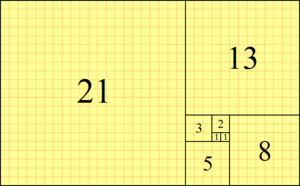Fibonacci number (nonfiction): Difference between revisions
From Gnomon Chronicles
No edit summary |
No edit summary |
||
| Line 1: | Line 1: | ||
In [[Mathematics (nonfiction)|mathematics]], the '''Fibonacci numbers''', commonly denoted Fn, form an [[Integer sequence (nonfiction)|integer sequence]], called the '''Fibonacci sequence''', such that each number is the [[Sum (nonfiction)|sum]] of the two preceding ones, starting from 0 and 1. | [[File:Fibonacci_blocks.png|thumb|A tiling with squares whose side lengths are successive Fibonacci numbers: 1, 1, 2, 3, 5, 8, 13 and 21.]]In [[Mathematics (nonfiction)|mathematics]], the '''Fibonacci numbers''', commonly denoted Fn, form an [[Integer sequence (nonfiction)|integer sequence]], called the '''Fibonacci sequence''', such that each number is the [[Sum (nonfiction)|sum]] of the two preceding ones, starting from 0 and 1. | ||
* [https://en.wikipedia.org/wiki/Fibonacci_number Fibonacci number] @ Wikipedia | * [https://en.wikipedia.org/wiki/Fibonacci_number Fibonacci number] @ Wikipedia | ||
Latest revision as of 08:21, 27 April 2020
In mathematics, the Fibonacci numbers, commonly denoted Fn, form an integer sequence, called the Fibonacci sequence, such that each number is the sum of the two preceding ones, starting from 0 and 1.
- Fibonacci number @ Wikipedia

